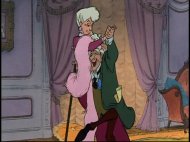[easyazon_image add_to_cart=”default” align=”left” asin=”B00EGXRTUQ” cloaking=”default” height=”160″ localization=”default” locale=”US” nofollow=”default” new_window=”default” src=”http://ecx.images-amazon.com/images/I/51rVesnunhL._SL160_.jpg” tag=”disabilitymovies-20″ width=”112″]In [easyazon_link asin=”B00EGXRTUQ” locale=”US” new_window=”default” nofollow=”default” tag=”disabilitymovies-20″ add_to_cart=”default” cloaking=”default” localization=”default” popups=”default”]The Five Pennies[/easyazon_link] Danny Kaye plays successful cornet player and bandleader Red Nichols during the Roaring Twenties, enjoying a lucrative career and jamming with the likes of Louis Armstrong, until his young daughter Dorothy contracts polio while he’s on tour. He and his wife Willa are taken to the bleak contagious diseases ward, where they are sternly warned by a fully gowned and masked nurse to keep their hands at their sides, not to touch the patients or anything a patient has touched, and not to pick up anything they’ve dropped. After the lecture they’re ushered into the vast ward filled with rows of iron lungs, their daughter unconscious in one of them. Red tosses his cornet off the Golden Gate Bridge in despair, perhaps as a symbolic suicide.
Red blames himself for sending Dorothy to boarding school during his tour, and takes umbrage when a doctor tells him Dorothy will likely never walk again. Dorothy, now in rehab and suffering from the depression common after a disabling illness, initially refuses to participate in physical therapy and expresses anger at her father for spending so much time away. To make up for it, Red buys a house in Los Angeles and quits the band to go to work in a local shipyard. This enables him to participate in the rest of her rehabilitation at home, covering Dorothy’s body with scalding hot towels and (in what is surely a Hollywood exaggeration) building Rube Goldberg-esque contraptions to squirt seltzer in his face if Dorothy lifted her foot high enough. In the relentless focus on physical therapy, even Dorothy’s 14th birthday song is the exhortation to “Stand up and say your name” while the camera focuses on her orthopedic shoe-clad feet and silver cane.
The records played at the birthday party bring back old memories of Red’s glory days on tour, and Dorothy blames herself for Red’s unhappiness. Dorothy and Willa conspire to have Red run into his old band members, hoping he’ll get back into the game. Red doesn’t want to “start at the bottom” and is afraid that after all these years of not playing, he’s “lost his lip”. Dorothy draws a parallel between her long rehabilitation and Red needing to learn things all over again, and convinces him to start small with a gig where she and her mother are essentially the only audience. Louis Armstrong and his band appear in a conga line to sing “When the Saints Go Marching In”, and just when you think there couldn’t possibly be any more allusions to the act of walking… Dorothy surprises Red with her first unassisted steps since contracting polio. Father and daughter waltz together, silver cane forgotten at the side.
In real life, Red had quit the music business in 1942, some time before his daughter contracted what was thought to be polio (or spinal meningitis) in 1943. Nor did he have trouble returning to it; by 1945 he had re-signed with Capital Records, and worked as a bandleader and performer until his death in 1965. But the pathos of an emotional struggle with a loved one’s disability and the relief of a pretty young girl walking again was required for a happy ending in Hollywood of that era.






